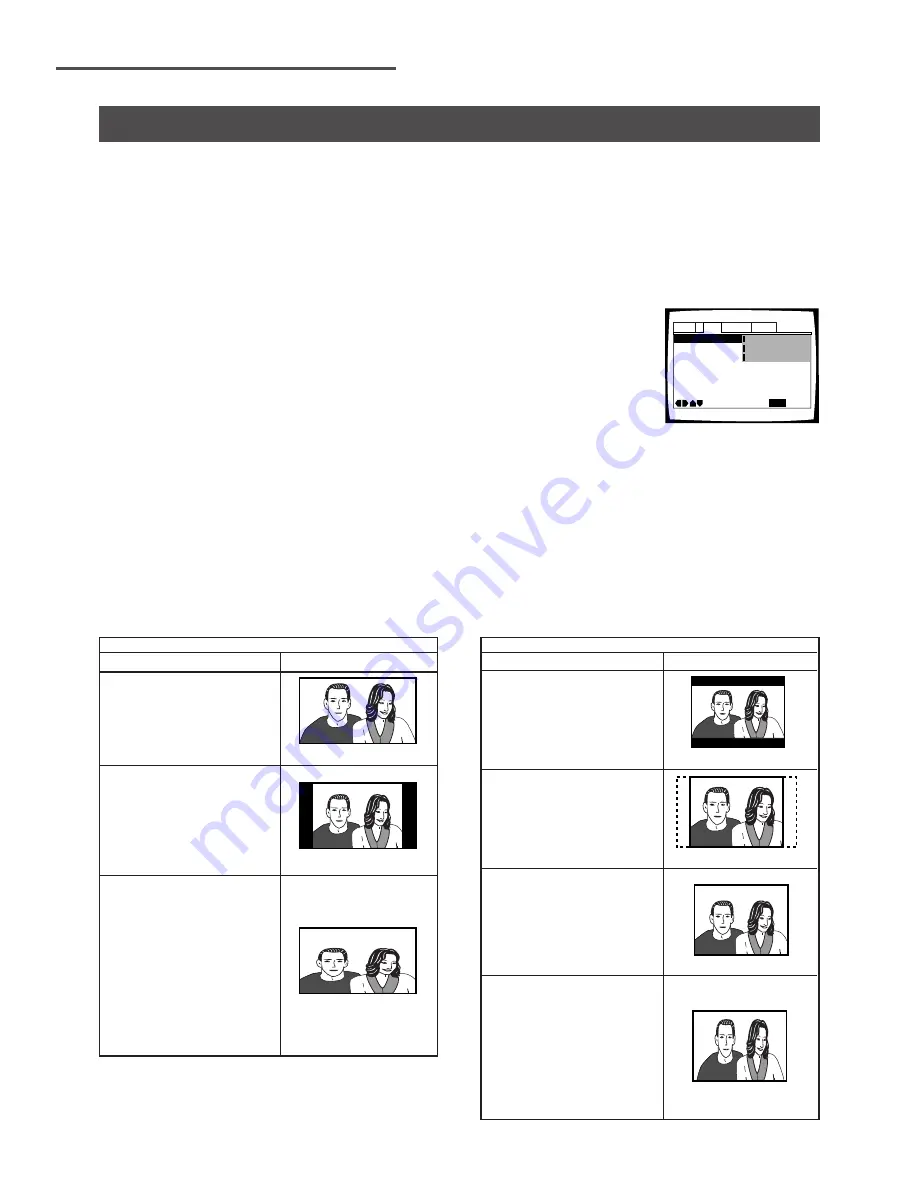
Adjusting Audio and Video Settings
36
En
The width-to-height ratio of conventional TVs is 4:3, while the width-to-
height ratio of wide screen and high-definition TVs is 16:9. This width-
to-height ratio is called the aspect ratio.
When viewing software recorded in different aspect ratios, the
image’s height to width ratio can be switched to match the TV or
monitor being used.
Please note that changes to the
[TV Screen]
setting cannot be made
when a disc is playing. Stop playback of the disc before attempting to
make any changes.
Settings:
4:3 (Letter Box)
4:3 (Pan & Scan)
16:9 (Wide) (Factory Setting)
Differences in screen sizes and DVD formats
The number of screen size formats currently available can be
somewhat confusing. If set incorrectly, the video presentation may not
appear as it should. The following diagrams and descriptions are
intended to help you set your TV screen size in a way that will allow
you to fully enjoy the digital video of DVD.
The settings in the
[TV Screen]
setting are perhaps most applicable
when the DVD you are watching is programmed in the wide screen
format. If you have a standard TV, select either
“4:3 (Letter Box)”
or
“4:3 (Pan & Scan)”
based on your personal preference. If you have a
wide screen TV, select
“16:9 (Wide)”
.
Setting the TV Screen Size
– DVD
Still Picture – Auto
Component Video – Interlace
On Screen Display – On
OSD Position – Normal
Angle Indicator – On
TV Screen
Audio1
General
Language
Video
2
Move
Exit
16:9(Wide)
4:3(Pan&Scan)
4:3(Letter Box)
SETUP
Notes
• If
“Standard (4:3)”
is selected in the
Setup Navigator screen,
“4:3 (Letter
Box)”
is selected on this screen. If you
prefer the pan&scan format, change the
settings on this screen.
• Whether the aspect can be switched or
not depends on the disc. Please refer to
the information written on the disc jacket,
etc.
• Some discs may not include the screen
format selected in the
[TV Screen]
setting. When this occurs, the standard
TV screen format available on the disc is
automatically selected.
When viewing a wide screen TV or monitor
Standard screen format DVD
When viewing a standard screen
format DVD on a wide screen
TV, black bars may be
automatically placed at the side
of the screen to adjust to the
DVD format.
Wide screen format DVD
Please note that there are some
wide screen letter box formats
that place black bars at the top
and bottom of the screen. This is
not a malfunction.
Standard screen format DVD
(unnatural stretched effect)
If you are viewing a standard
screen format DVD on a wide
screen TV, the picture may
appear ‘stretched’ on the
screen. To remedy this
condition, change your wide
screen TV to display a standard
(4:3) screen. Refer to the
instructions supplied with your
wide screen TV or monitor for
more information.
DVD screen size format
Setting and Appearance
“Wide” setting
“Wide” setting
“Wide” setting
Standard screen format DVD
If you have a standard TV, the
standard screen format will be
presented regardless of the
setting.
When viewing a standard size TV or monitor
Wide screen format DVD
The Pan & Scan presentation
crops both sides of the wide
screen presentation to use the
full standard TV screen.
Wide screen format DVD
The Letter box presentation
places black bars at the top and
bottom portions of the screen to
provide the full wide screen
presentation of a movie on a
standard TV (4:3 aspect ratio).
Wide screen format DVD
(unnatural squeezed effect)
If you are viewing a wide screen
format DVD on a standard TV and
the
[TV Screen]
setting is set to
“16:9(Wide)”
, the picture may
appear ‘squeezed’ on the screen.
To remedy this condition, select
either
“4:3(Letter Box)”
or
”4:3(Pan & Scan)”
.
DVD screen size format
Setting and Appearance
“Letter Box” setting
“Pan & Scan” setting
Any setting
“Wide” setting






























